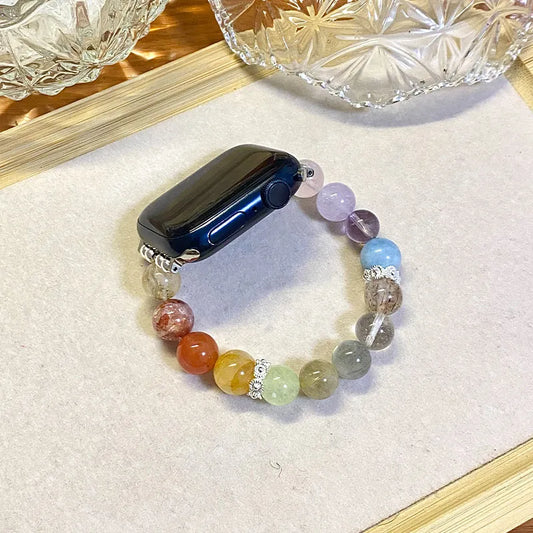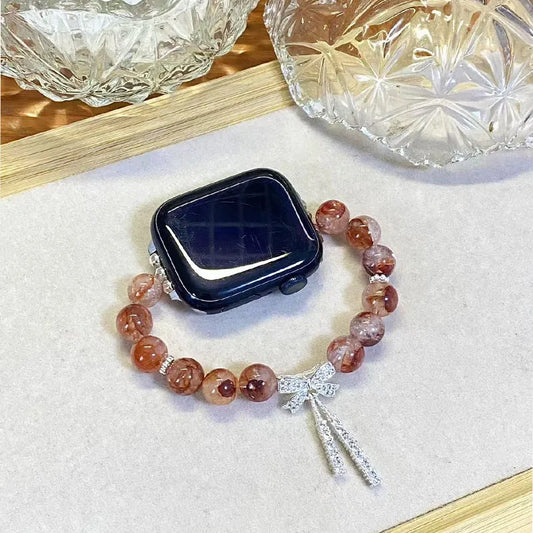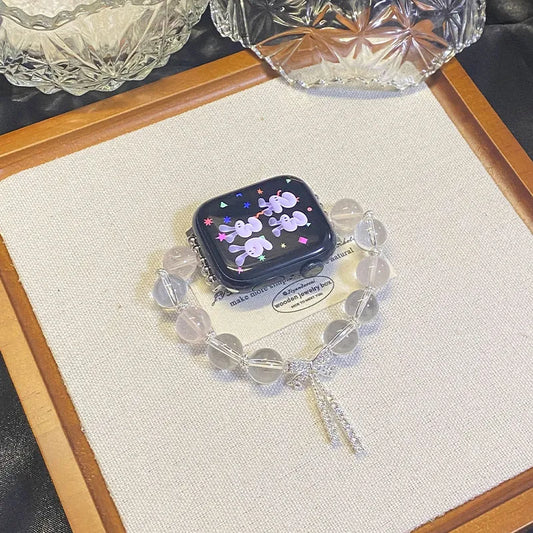A decade ago, most people associated 'ceramic' with pottery and delicate teacups. The word itself comes from the Greek 'kerameikos,' meaning 'for pottery.'
However, ceramics have now transcended their traditional roles, becoming a key material in advanced technologies. Nowhere is this more apparent than in the watchmaking industry, where ceramic watch bands are celebrated for their combination of strength, durability, and aesthetic appeal.
This article delves into the materials and processes behind ceramic watch bands and explores why they have become a popular choice among watch enthusiasts.
The Evolution of Ceramic Materials

Ceramics have been utilized by humans for thousands of years, with the earliest known ceramics dating back over 27,000 years. Initially, ceramics were primarily used for creating pottery and figurines. However, the development of technical ceramics in the 20th century marked a significant advancement, allowing ceramics to be used in a variety of high-tech applications, including watchmaking.
What Are Ceramic Watch Bands Made Of?

Ceramic watch bands are primarily made from a high-tech material known as zirconium dioxide (ZrO2), or zirconia. This advanced ceramic offers exceptional hardness, scratch resistance, and a glossy finish that remains untarnished over time. Let’s delve deeper into the characteristics and advantages of zirconium dioxide to understand why it is favored in high-end watchmaking.
The Creation of Zirconium Dioxide
Zirconium dioxide is an inorganic, non-metallic material produced through a high-temperature process. Here’s how it’s made:
- Powder Preparation: The initial step involves grinding zirconium dioxide into a fine powder to ensure uniform particle size and consistency. This powder must be meticulously processed to eliminate any impurities that could affect the final product’s quality.
- Forming: This powder is then shaped into the desired forms using techniques such as injection molding or pressing. During this stage, the powder is mixed with binders and other additives to help it hold its shape.
- Sintering: The shaped pieces are heated to temperatures exceeding 1,500°C (2,732°F). This sintering process fuses the particles together, creating a dense and robust material. Sintering not only solidifies the shape but also enhances the material's strength and durability.
- Finishing: Finally, the ceramic is meticulously polished to achieve a smooth, high-gloss surface that is both visually appealing and comfortable to wear. This step often involves multiple stages of grinding and polishing to achieve the desired finish.
Benefits of Ceramic Watch Bands
Ceramic watch bands offer several distinct advantages over traditional materials like stainless steel and leather. These benefits contribute to their growing popularity among watch enthusiasts and manufacturers alike.

Exceptional Durability
One of the most significant advantages of ceramic watch bands is their exceptional durability.
Zirconium dioxide is extremely hard, ranking just below diamonds on the Mohs hardness scale. This hardness makes ceramic watch bands highly resistant to scratches and everyday wear, ensuring that they retain their pristine appearance for years.
Lightweight Comfort
Despite their hardness, ceramic watch bands are surprisingly lightweight.
This lightweight nature enhances the overall comfort of wearing a ceramic watch, making it ideal for daily use. The reduced weight does not compromise the band’s strength, providing a perfect balance between durability and comfort.
Hypoallergenic Properties
For individuals with sensitive skin or metal allergies, ceramic watch bands are an excellent choice.
Zirconium dioxide is hypoallergenic, meaning it does not cause skin irritation or allergic reactions. This property makes ceramic bands a suitable option for anyone prone to skin sensitivities.
Aesthetic Versatility
Ceramic watch bands are known for their glossy finish, which provides a modern and sophisticated look.
The polishing process gives ceramic a lustrous appearance that enhances the overall design of the watch. Additionally, ceramic can be manufactured in a variety of colors, allowing for personalized and stylish designs. Whether you prefer a classic black or a bold white band, ceramic offers a wide range of aesthetic possibilities.
The Manufacturing Process of Ceramic Watch Bands
To fully appreciate the qualities of ceramic watch bands, it’s essential to understand the detailed manufacturing process. Each stage of production is critical in ensuring the final product meets the high standards expected of luxury watch components.
Powder Preparation
The journey of a ceramic watch band begins with the preparation of zirconium dioxide powder. This powder must be of high purity and finely ground to ensure uniform particle size. Any impurities in the powder can affect the strength and appearance of the final product, so meticulous processing is crucial.
Forming the Ceramic
Once the powder is prepared, it is mixed with binders and other additives to create a material that can be shaped. The mixture is then formed into the desired shape using methods such as injection molding or pressing. These techniques allow for precise control over the shape and size of the ceramic components, ensuring they fit perfectly into the watch design.
Sintering Process
The formed ceramic pieces are then subjected to the sintering process, where they are heated to extremely high temperatures. During sintering, the particles of zirconium dioxide fuse together, creating a dense and strong material. This process not only solidifies the shape but also enhances the mechanical properties of the ceramic, making it suitable for use in high-stress applications like watch bands.
Polishing and Finishing
The final step in the manufacturing process is polishing the ceramic pieces to achieve a smooth, glossy finish. This step involves multiple stages of grinding and polishing, using progressively finer abrasives to remove any surface imperfections and bring out the material’s natural luster. The result is a sleek, polished surface that is both attractive and comfortable to wear.
The Role of Ceramic in Modern Watchmaking

The use of ceramic in watchmaking is a relatively recent innovation, but it has quickly gained traction due to its unique properties. Here are some milestones in the development and adoption of ceramic watch bands in the industry:
Early Applications
The initial use of ceramics in watches focused on enhancing the durability of bezels and cases. These early applications demonstrated the material’s potential to withstand daily wear and tear, paving the way for more extensive use in other components.
Technological Advancements
Advancements in ceramic manufacturing techniques during the 1980s and 1990s significantly improved the material’s properties. These improvements made it feasible to produce more intricate and durable ceramic components, including watch bands. The ability to create complex shapes with high precision opened up new possibilities for watch design and functionality.
Modern Popularity
Today, ceramic is a staple in luxury watchmaking. Many high-end brands offer ceramic models known for their resilience and chic appeal. The combination of durability, comfort, and aesthetic versatility makes ceramic an ideal material for modern watch bands. As a result, ceramic watches have become highly sought after by collectors and enthusiasts alike.
Comparing Ceramic Watch Bands to Other Materials
To fully appreciate the advantages of ceramic watch bands, it’s helpful to compare them to other common materials used in watchmaking, such as stainless steel and leather.
Stainless Steel Watch Bands

Stainless steel is a popular material for watch bands due to its strength and durability. However, it is prone to scratching and can become discolored over time. Stainless steel bands are also heavier than ceramic, which can make them less comfortable for prolonged wear. While stainless steel is hypoallergenic, it may still cause irritation for individuals with very sensitive skin.
Leather Watch Bands

Leather watch bands offer a classic and elegant look. They are generally lightweight and comfortable, but they are not as durable as ceramic or stainless steel. Leather bands are susceptible to wear and tear, particularly from exposure to moisture and sweat. Additionally, leather is not hypoallergenic, and some people may experience skin irritation from prolonged contact.
Ceramic Watch Bands
In comparison, ceramic watch bands combine the best qualities of both stainless steel and leather. They offer exceptional durability and scratch resistance while being lightweight and comfortable. The hypoallergenic properties of zirconium dioxide make ceramic bands suitable for individuals with sensitive skin. Moreover, the aesthetic versatility of ceramic allows for a wide range of stylish designs, making it an ideal material for both casual and formal watches.
Conclusion
Ceramic watch bands represent a remarkable advancement in material science, offering a combination of durability, comfort, and aesthetic appeal that is unmatched by traditional materials.
From their origins in ancient pottery to their current status as a cutting-edge material, ceramics have undergone a fascinating transformation.
Next time you admire the sleek, scratch-resistant band of a ceramic watch, remember that it symbolizes not just a fashion statement but also a significant achievement in scientific and engineering innovation. Ceramic watch bands offer a perfect blend of practicality and elegance, making them an excellent choice for anyone seeking both durability and sophistication in their timepieces.
FAQs
Can stainless steel scratch ceramic?
No, stainless steel cannot scratch ceramic as ceramic is harder than stainless steel. However, materials harder than ceramic, like diamonds, can cause scratches.
How to clean a ceramic watch strap?
To clean a ceramic watch strap, use a soft cloth with a mild soap and water solution. Gently wipe the strap and avoid using harsh chemicals that could damage the ceramic surface. For more information, see How to Clean and Maintain Your Apple Watch Bands.
Can I use alcohol to clean my Apple Watch band?
Yes, you can use a small amount of 70% isopropyl alcohol to clean your Apple Watch band. Apply the alcohol to a soft cloth and gently wipe the band. Avoid getting alcohol on other parts of the watch.
Are ceramic watch bands completely scratch-proof?
No, ceramic watch bands are highly scratch-resistant but not entirely scratch-proof. They can still be scratched by materials harder than ceramic, such as diamonds.
Can ceramic watch bands crack?
Yes, while ceramic watch bands are highly resistant to scratches, they can crack or chip if subjected to a strong impact. Handle your watch with care to avoid accidental damage.







